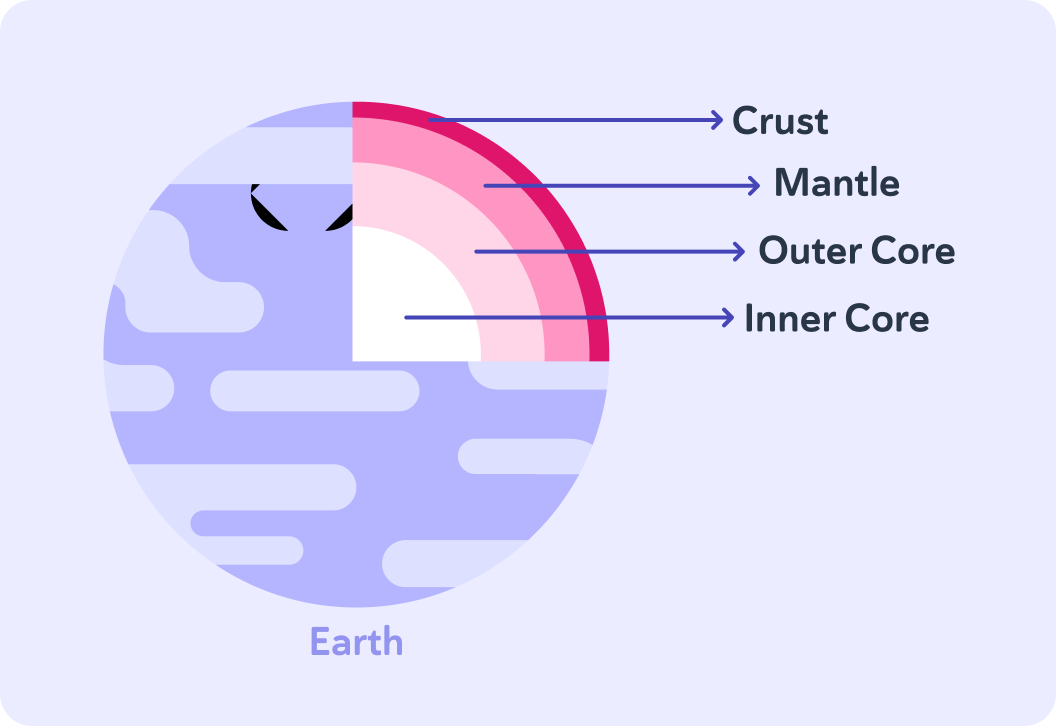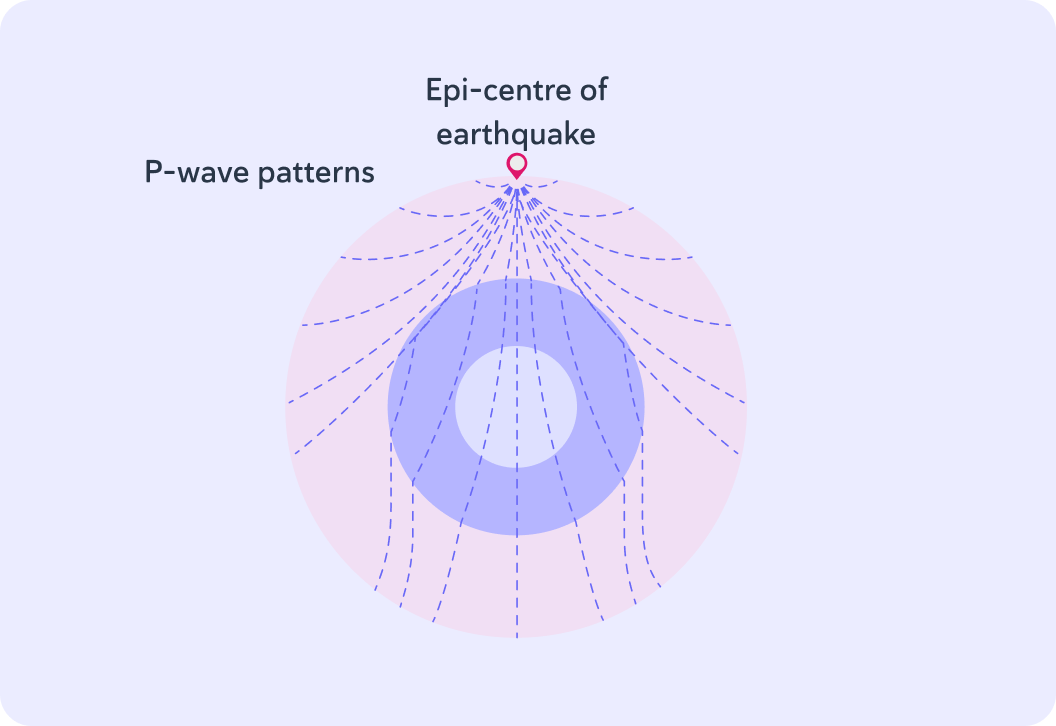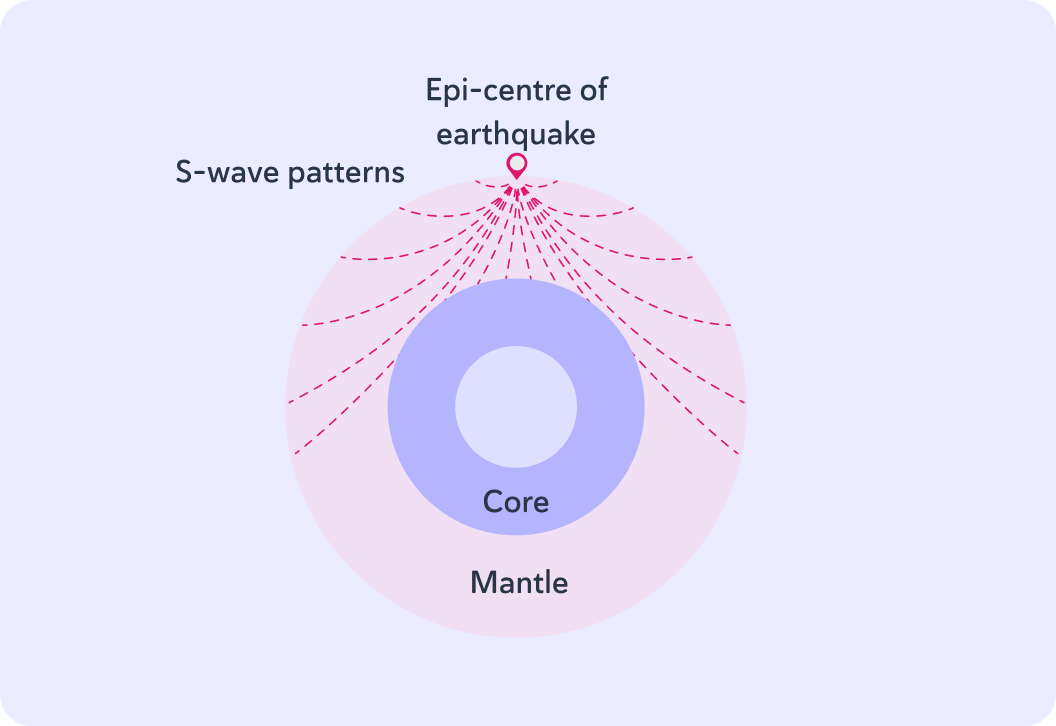YOU ARE LEARNING:
What Seismic Waves Are and What They Can Tell Us

What Seismic Waves Are and What They Can Tell Us
Earthquakes produce seismic waves which can either be longitudinal (P-waves) or transverse (S-waves). Monitoring these allow us to determine the internal structure of the Earth.
In this lesson, we shall be looking a seismic waves, how they are formed and what they can tell us about the structure of the Earth.
Through the study of seismic waves, scientists have been able to find out what the Earth's core is like. So where do you think seismic waves come from?

In the image above you can see the 4 layers that make up the Earth. Which letter do you think represents the inner core of the Earth?


The inner core of the Earth is a solid.
The layer above it is called the outer core. It is made up of nickel and iron and it is liquid.

From looking at the image above, what do we call the outermost layer of the Earth?


The outermost layer of the Earth is the solid crust.
It only has a maximum depth of around 50km. This is very thin!

Underneath the crust we have the mantle.
The mantle is also a solid. Sudden movement between the tectonic plates in the Earth’s crust is what causes earthquakes. Earthquakes produce seismic waves.

Out of the four layers which make up the internal structure of the Earth, which one is liquid?

How do we know what the internal structure of the Earth is?
True or false? Scientists can directly observe the internal structure of the Earth.

The crust has a maximum depth of round 50km and even our deepest mines are only a few kilometres deep.
Scientists use seismic waves to figure out what the internal structure of the Earth is.
Waves in general can be categorised into two types. Can you remember what these are?

There are two types of seismic waves.
Primary waves or "P-waves" are longitudinal seismic waves.
These are the fastest seismic waves. They average at 6km/s
Secondary waves or "S-waves" are transverse seismic waves.
S-waves are slower than P-waves. They average about 4km/s
This image shows the motion of P-waves. They are produced at the epicentre, which is the point on the earth's surface directly above the focus of an earthquake. From looking at the image, can P-waves travel through liquid?


In this image shows the motion of S-waves. Can these travel through liquid?


The waves curve when they travel through the Earth due to changes in density. What is this phenomena called? It is the same word we use for when light slows down in water.


Both S- and P-waves travel through the earth. We can measure them around the world where they emerge. Maybe you have heard the name of the machines we use to measure them. We call them __________________.


In this image we have marked a "shadow zone". What do you think we mean by "shadow zone"?
A) The sun never shines there. B) Earthquakes never hit there. C) Seismometers can't measure anything there.


The shadow zones are areas where seismic waves don't reach.
Scientists can map out these shadow zones to understand how the seismic waves move through the Earth. They can use that information to conclude things about the structure of the Earth.

So if you know that S-waves can't move through liquid and there are S-wave shadow zones, then that must mean that part of the Earth's structure is...
A) liquid. B) solid.


P-waves can travel through liquid, but scientists have found P-wave shadow zones, nonetheless! These patterns are a result of P-waves changing direction whilst travelling through the layers which have different densities. What do we call this phenomena again?


P-waves shadow zones occur because P-waves travel faster in solids than in liquids.
P-waves slow down as they enter the liquid outer core which makes them bend (refract). This confirms that the outer core must be a liquid.

Sometimes faint P-waves can be detected in the P-waves shadow zone.
That is evidence for a solid inner core.

Seismic waves are created by earthquakes. They carry energy away from the epicentre of an earthquake. They pass through the Earth and can be detected around the world by seismometers on the Earth's surface. Seismometers record the vibrations of the earthquakes. By measuring these waves and by studying shadow zones, scientists have worked out how the interior of the Earth must be structured.
So earthquakes create seismic waves which can be detected around the word and help scientists study the structure of the Earth.
The Earth is made up of 4 layers: The crust (solid), the mantle (solid), the outer core (liquid) and the inner core (solid).

There are two kinds of seismic waves.
P-waves are longitudinal waves which can travel through both liquids and solids. They are faster than S-waves. S-waves are transverse waves which can only travel through solids. They are slower than P-waves.

